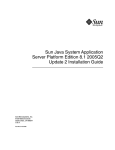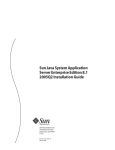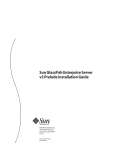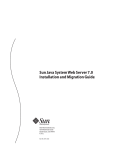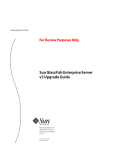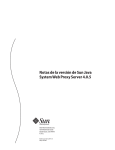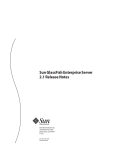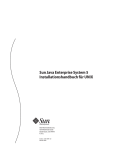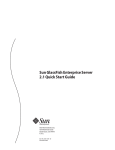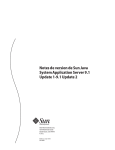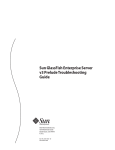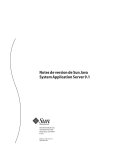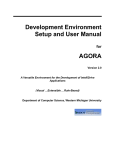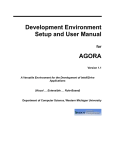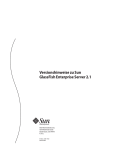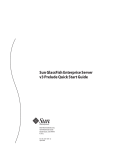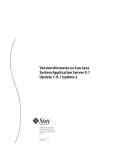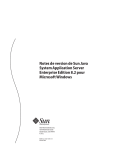Download Sun Java System Application Server 91 Installation Guide
Transcript
Sun Java System Application
Server 9.1 Installation Guide
Sun Microsystems, Inc.
4150 Network Circle
Santa Clara, CA 95054
U.S.A.
Part No: 819–3670–10
September 2007
Copyright 2007 Sun Microsystems, Inc.
4150 Network Circle, Santa Clara, CA 95054 U.S.A.
All rights reserved.
This product or document is protected by copyright and distributed under licenses restricting its use, copying, distribution, and decompilation. No part of this
product or document may be reproduced in any form by any means without prior written authorization of Sun and its licensors, if any. Third-party software,
including font technology, is copyrighted and licensed from Sun suppliers.
Parts of the product may be derived from Berkeley BSD systems, licensed from the University of California. UNIX is a registered trademark in the U.S. and other
countries, exclusively licensed through X/Open Company, Ltd.
Sun, Sun Microsystems, the Sun logo, docs.sun.com, AnswerBook, AnswerBook2, and Solaris are trademarks or registered trademarks of Sun Microsystems, Inc. in
the U.S. and other countries. All SPARC trademarks are used under license and are trademarks or registered trademarks of SPARC International, Inc. in the U.S. and
other countries. Products bearing SPARC trademarks are based upon an architecture developed by Sun Microsystems, Inc.
The OPEN LOOK and SunTM Graphical User Interface was developed by Sun Microsystems, Inc. for its users and licensees. Sun acknowledges the pioneering efforts
of Xerox in researching and developing the concept of visual or graphical user interfaces for the computer industry. Sun holds a non-exclusive license from Xerox to
the Xerox Graphical User Interface, which license also covers Sun's licensees who implement OPEN LOOK GUIs and otherwise comply with Sun's written license
agreements.
U.S. Government Rights – Commercial software. Government users are subject to the Sun Microsystems, Inc. standard license agreement and applicable provisions
of the FAR and its supplements.
DOCUMENTATION IS PROVIDED “AS IS” AND ALL EXPRESS OR IMPLIED CONDITIONS, REPRESENTATIONS AND WARRANTIES, INCLUDING ANY
IMPLIED WARRANTY OF MERCHANTABILITY, FITNESS FOR A PARTICULAR PURPOSE OR NON-INFRINGEMENT, ARE DISCLAIMED, EXCEPT TO
THE EXTENT THAT SUCH DISCLAIMERS ARE HELD TO BE LEGALLY INVALID.
Copyright 2007 Sun Microsystems, Inc.
4150 Network Circle, Santa Clara, CA 95054 U.S.A.
Tous droits réservés.
Des parties de ce produit pourront être dérivées du système Berkeley BSD licenciés par l'Université de Californie. UNIX est une marque déposée aux Etats-Unis et
dans d'autres pays et licenciée exclusivement par X/Open Company, Ltd.
Sun, Sun Microsystems, le logo Sun, docs.sun.com, AnswerBook, AnswerBook2, et Solaris sont des marques de fabrique ou des marques déposées, de Sun
Microsystems, Inc. aux Etats-Unis et dans d'autres pays. Toutes les marques SPARC sont utilisées sous licence et sont des marques de fabrique ou des marques
déposées de SPARC International, Inc. aux Etats-Unis et dans d'autres pays. Les produits portant les marques SPARC sont basés sur une architecture développée par
Sun Microsystems, Inc.
L'interface d'utilisation graphique OPEN LOOK et Sun a été développée par Sun Microsystems, Inc. pour ses utilisateurs et licenciés. Sun reconnaît les efforts de
pionniers de Xerox pour la recherche et le développement du concept des interfaces d'utilisation visuelle ou graphique pour l'industrie de l'informatique. Sun détient
une licence non exclusive de Xerox sur l'interface d'utilisation graphique Xerox, cette licence couvrant également les licenciés de Sun qui mettent en place l'interface
d'utilisation graphique OPEN LOOK et qui en outre se conforment aux licences écrites de Sun.
CETTE PUBLICATION EST FOURNIE “EN L'ETAT” ET AUCUNE GARANTIE, EXPRESSE OU IMPLICITE, N'EST ACCORDEE, Y COMPRIS DES
GARANTIES CONCERNANT LA VALEUR MARCHANDE, L'APTITUDE DE LA PUBLICATION A REPONDRE A UNE UTILISATION PARTICULIERE, OU
LE FAIT QU'ELLE NE SOIT PAS CONTREFAISANTE DE PRODUIT DE TIERS. CE DENI DE GARANTIE NE S'APPLIQUERAIT PAS, DANS LA MESURE OU
IL SERAIT TENU JURIDIQUEMENT NUL ET NON AVENU.
071122@19028
Contents
Preface .....................................................................................................................................................9
1
Installing Application Server Software ........................................................................................... 15
Distribution Types and Their Components ..................................................................................... 15
Installing GlassFish v2 ........................................................................................................................ 16
▼ To Install GlassFish Application Server .................................................................................... 16
▼ To Install the Load Balancing Plug-in (standalone) ................................................................ 17
Application Server 9.1 with Java ES 5 Update 1 ............................................................................... 18
▼ To Perform a Cleanup after Partial Installation ....................................................................... 18
▼ To Configure Registry Server with Application Server 9.1 ..................................................... 19
Installing Application Server 9.1 ........................................................................................................ 20
▼ To Install Application Server 9.1 without HADB ..................................................................... 20
▼ To Install Application Server 9.1 with HADB ........................................................................... 22
To Install Application Server 9.1 in Silent Mode ...................................................................... 27
Application Server and Solaris 10 Zones .......................................................................................... 32
Application Server and MQ bundled with Solaris 10 .............................................................. 32
Propagation Levels of Components Installed Through Java ES 5 Update 1 ......................... 33
2
Uninstalling Application Server Software ...................................................................................... 35
Running the Uninstallation Program ............................................................................................... 35
▼ To Run the Uninstallation Program on UNIX or Linux ......................................................... 36
▼ To Run the Uninstallation Program on Windows ................................................................... 36
Index ......................................................................................................................................................39
3
4
Tables
TABLE 1–1
Installation Configuration File Variables ............................................................... 29
5
6
Examples
EXAMPLE 1–1
Installation Configuration File Example ................................................................ 28
7
8
Preface
This Installation Guide contains instructions for installing and uninstalling GlassFish
Application Server and the Sun JavaTM System Application Server.
This preface contains information about and conventions for the entire Sun Java System
Application Server documentation set.
Application Server Documentation Set
The Application Server documentation set describes deployment planning and system
installation. The Uniform Resource Locator (URL) for Application Server documentation is
http://docs.sun.com/coll/1343.4. For an introduction to Application Server, refer to the
books in the order in which they are listed in the following table.
TABLE P–1
Books in the Application Server Documentation Set
Book Title
Description
Documentation Center
Application Server documentation topics organized by task and subject.
Release Notes
Late-breaking information about the software and the documentation. Includes a
comprehensive, table-based summary of the supported hardware, operating system, Java
Development Kit (JDKTM), and database drivers.
Quick Start Guide
How to get started with the Application Server product.
Installation Guide
Installing the software and its components.
Deployment Planning Guide
Evaluating your system needs and enterprise to ensure that you deploy the Application Server
in a manner that best suits your site. General issues and concerns that you must be aware of
when deploying the server are also discussed.
Application Deployment Guide
Deployment of applications and application components to the Application Server. Includes
information about deployment descriptors.
Developer’s Guide
Creating and implementing Java Platform, Enterprise Edition (Java EE platform) applications
intended to run on the Application Server that follow the open Java standards model for Java
EE components and APIs. Includes information about developer tools, security, debugging,
and creating lifecycle modules.
9
Preface
TABLE P–1
Books in the Application Server Documentation Set
(Continued)
Book Title
Description
Java EE 5 Tutorial
Using Java EE 5 platform technologies and APIs to develop Java EE applications.
Java WSIT Tutorial
Developing web applications using the Web Service Interoperability Technologies (WSIT).
Describes how, when, and why to use the WSIT technologies and the features and options
that each technology supports.
Administration Guide
System administration for the Application Server, including configuration, monitoring,
security, resource management, and web services management.
High Availability Administration
Guide
Post-installation configuration and administration instructions for the high-availability
database.
Administration Reference
Editing the Application Server configuration file, domain.xml.
Upgrade and Migration Guide
Upgrading from an older version of Application Server or migrating Java EE applications
from competitive application servers. This guide also describes differences between adjacent
product releases and configuration options that can result in incompatibility with the product
specifications.
Performance Tuning Guide
Tuning the Application Server to improve performance.
Troubleshooting Guide
Solving Application Server problems.
Error Message Reference
Solving Application Server error messages.
Reference Manual
Utility commands available with the Application Server; written in man page style. Includes
the asadmin command line interface.
Related Documentation
Application Server can be purchased by itself or as a component of Sun Java Enterprise System
(Java ES), a software infrastructure that supports enterprise applications distributed across a
network or Internet environment. If you purchased Application Server as a component of
Java ES, you should be familiar with the system documentation at
http://docs.sun.com/coll/1286.2. The URL for all documentation about Java ES and its
components is http://docs.sun.com/prod/entsys.5.
For documentation about other stand-alone Sun Java System server products, go to the
following:
■
■
■
Message Queue documentation (http://docs.sun.com/coll/1343.4)
Directory Server documentation (http://docs.sun.com/coll/1224.1)
Web Server documentation (http://docs.sun.com/coll/1308.3)
A JavadocTM tool reference for packages provided with the Application Server is located at
http://glassfish.dev.java.net/nonav/javaee5/api/index.html. Additionally, the
following resources might be useful:
10
Sun Java System Application Server 9.1 Installation Guide • September 2007
Preface
■
■
The Java EE 5 Specifications (http://java.sun.com/javaee/5/javatech.html)
The Java EE Blueprints (http://java.sun.com/reference/blueprints/index.html)
For information on creating enterprise applications in the NetBeansTM Integrated Development
Environment (IDE), see http://www.netbeans.org/kb/55/index.html.
For information about the Java DB database included with the Application Server, see
http://developers.sun.com/javadb/.
The GlassFish Samples project is a collection of sample applications that demonstrate a broad
range of Java EE technologies. The GlassFish Samples are bundled with the Java EE Software
Development Kit (SDK), and are also available from the GlassFish Samples project page at
https://glassfish-samples.dev.java.net/.
Default Paths and File Names
The following table describes the default paths and file names that are used in this book.
TABLE P–2
Default Paths and File Names
Placeholder
Description
Default Value
install-dir
Represents the base installation directory for
Application Server.
Application Server installed with Java ES on SolarisTM, root user:
/opt/SUNWappserver/appserver
Application Server installed with Java ES on Linux, root user:
/opt/sun/appserver/
Other Solaris and Linux installations, non-root user:
user’s-home-directory/SUNWappserver
Other Solaris and Linux installations, root user:
/opt/SUNWappserver
Windows, all installations:
SystemDrive:\Sun\AppServer
11
Preface
TABLE P–2
Default Paths and File Names
(Continued)
Placeholder
Description
Default Value
domain-root-dir
Represents the directory containing all
domains.
Java ES Solaris installations, root user:
/var/opt/SUNWappserver/domains/
Java ES Linux installations, root user:
/var/opt/sun/appserver/domains/
All other installations:
install-dir/domains/
domain-dir
Represents the directory for a domain.
domain-root-dir/domain-dir
In configuration files, you might see
domain-dir represented as follows:
${com.sun.aas.instanceRoot}
instance-dir
Represents the directory for a server instance.
domain-dir/instance-dir
Typographic Conventions
The following table describes the typographic changes that are used in this book.
TABLE P–3
Typographic Conventions
Typeface
Meaning
Example
AaBbCc123
The names of commands, files, and
directories, and onscreen computer
output
Edit your .login file.
Use ls -a to list all files.
machine_name% you have mail.
What you type, contrasted with onscreen
computer output
machine_name% su
AaBbCc123
A placeholder to be replaced with a real
name or value
The command to remove a file is rm filename.
AaBbCc123
Book titles, new terms, and terms to be
emphasized (note that some emphasized
items appear bold online)
Read Chapter 6 in the User's Guide.
AaBbCc123
Password:
A cache is a copy that is stored locally.
Do not save the file.
12
Sun Java System Application Server 9.1 Installation Guide • September 2007
Preface
Symbol Conventions
The following table explains symbols that might be used in this book.
TABLE P–4
Symbol Conventions
Symbol
Description
Example
Meaning
[]
Contains optional arguments ls [-l]
and command options.
The -l option is not required.
{|}
Contains a set of choices for a -d {y|n}
required command option.
The -d option requires that you use
either the y argument or the n
argument.
${ }
Indicates a variable
reference.
${com.sun.javaRoot}
References the value of the
com.sun.javaRoot variable.
-
Joins simultaneous multiple
keystrokes.
Control-A
Press the Control key while you press
the A key.
+
Joins consecutive multiple
keystrokes.
Ctrl+A+N
Press the Control key, release it, and
then press the subsequent keys.
→
Indicates menu item
selection in a graphical user
interface.
File → New → Templates
From the File menu, choose New.
From the New submenu, choose
Templates.
Documentation, Support, and Training
The Sun web site provides information about the following additional resources:
■
■
■
Documentation (http://www.sun.com/documentation/)
Support (http://www.sun.com/support/)
Training (http://www.sun.com/training/)
Searching Sun Product Documentation
Besides searching Sun product documentation from the docs.sun.comSM web site, you can use a
search engine by typing the following syntax in the search field:
search-term site:docs.sun.com
For example, to search for “broker,” type the following:
broker site:docs.sun.com
13
Preface
To include other Sun web sites in your search (for example, java.sun.com, www.sun.com, and
developers.sun.com), use sun.com in place of docs.sun.com in the search field.
Third-Party Web Site References
Third-party URLs are referenced in this document and provide additional, related information.
Note – Sun is not responsible for the availability of third-party web sites mentioned in this
document. Sun does not endorse and is not responsible or liable for any content, advertising,
products, or other materials that are available on or through such sites or resources. Sun will not
be responsible or liable for any actual or alleged damage or loss caused or alleged to be caused by
or in connection with use of or reliance on any such content, goods, or services that are available
on or through such sites or resources.
Sun Welcomes Your Comments
Sun is interested in improving its documentation and welcomes your comments and
suggestions. To share your comments, go to http://docs.sun.com and click Send Comments.
In the online form, provide the full document title and part number. The part number is a
7-digit or 9-digit number that can be found on the book's title page or in the document's URL.
For example, the part number of this book is 819-3670.
14
Sun Java System Application Server 9.1 Installation Guide • September 2007
1
C H A P T E R
1
Installing Application Server Software
This chapter provides instructions for installing the Sun Java System Application Server
software. The following topics are discussed:
■
■
■
■
■
“Distribution Types and Their Components” on page 15
“Installing GlassFish v2” on page 16
“ Application Server 9.1 with Java ES 5 Update 1” on page 18
“Installing Application Server 9.1” on page 20
“Application Server and Solaris 10 Zones” on page 32
Distribution Types and Their Components
You can download GlassFish Application Server from
https://glassfish.dev.java.net/public/downloadsindex.html. The GlassFish v2
distribution includes the Application Server software, the Sun Java System Message Queue 4.1,
Java DB, and ant 1.6.5. You can run GlassFish on Solaris SPARC, Solaris x86, Linux, Windows,
and Mac OS.
Application Server 9.1 product distribution is available as: Application Server 9.1 with HADB
and Application Server 9.1 without HADB. The standalone Application Server 9.1 is available at
http://www.sun.com/download.
Application Server 9.1 without HADB includes the load balancing plug-in, Java DB, and Sun
Java System Message Queue 4.1. Application Server 9.1 with HADB includes the load balancing
plug-in, Java SE Development Kit (JDK) 5, Java DB, Sun Java System Message Queue 4.1, and
HADB.
The Java ES 5 Update 1 distribution includes a Application Server 9.1 distribution as an
optional download. This distribution includes HADB in addition to the load balancing plug-in,
Java Development Kit (JDK) 5, Java DB, and the Sun Java System Message Queue 4.1.
15
Installing GlassFish v2
Application Server 9.1 is also part of the Java EE SDK and the Java Application Platform SDK.
You can download these distributions from
http://java.sun.com/javaee/downloads/index.jsp.
You can download the latest version of Sun Java System Access Manager Policy Agent 2.2 from
http://www.sun.com/download. For more information on how the Access Manager Policy
Agent works with the Application Server 9.1, see Sun Java System Access Manager Policy Agent
2.2 Guide for Sun Java System Application Server 9.0/9.1 on docs.sun.com.
Installing GlassFish v2
This section provides instructions for installing GlassFish v2 distribution and for installing the
load balancing plug-in for GlassFish v2. This distribution does not support upgrades or
patching.
■
■
▼
Before You Begin
“To Install GlassFish Application Server ” on page 16
“To Install the Load Balancing Plug-in (standalone)” on page 17
To Install GlassFish Application Server
Get JDK (Java SE Developerment Kit) 5 or higher from http://java.sun.com/javase/, if you
are using Solaris, Linux, or Windows..
If you are using Mac OS X, you need to download JDK 5 (supported on Mac OS X 1.4 or later)
from http://www.apple.com/support/downloads/java2se50release3.html and make JDK
5 the default JVM.
1
Download the GlassFish v2 distribution
https://glassfish.dev.java.net/public/downloadsindex.html.
2
Set the environment variable JAVA_HOME to point to the directory in which JDK 5 is installed.
3
Run the following command:
java -Xmx256m -jar <filename>.jar
4
Set ANT_HOME to point to the ant 1.6.5 installation, which is at
<downloaded-dir>/glassfish/lib/ant directory.
5
Navigate to the glassfish directory:
cd glassfish
16
Sun Java System Application Server 9.1 Installation Guide • September 2007
Installing GlassFish v2
6
If you do not want clustering capabilities, run the following command:
ant -f setup.xml
■
If you want to use GlassFish with clustering, change the command to:
ant -f setup-cluster.xml
▼
To Install the Load Balancing Plug-in (standalone)
Use the procedures in this section if the load balancing plug-in is not part of the Application
Server distribution you are using. If you are using the Sun Java System Application Server 9.1
(bundle with HADB), see “To Install Application Server 9.1 with HADB” on page 22 for
instructions for installing the load balancing plug-in.
The load balancing plug-in is not currently bundled with the GlassFish v2Application Server. If
you want load balancing capabilities, you can download the load balancing plug-in from the
following locations:
■
■
■
■
■
Solaris (SPARC): http://download.java.net/javaee5/external/SunOS/aslb/jars/
Solaris (x86): http://download.java.net/javaee5/external/SunOS_X86/aslb/jars/
Linux: http://download.java.net/javaee5/external/Linux/aslb/jars/
Windows: http://download.java.net/javaee5/external/WINNT/aslb/jars/
Mac OS: http://download.java.net/javaee5/external/Darwin/aslb/jars/
1
Before you install the load balancer plug-in, ensure that you have installed a supported web
server. For a list of supported web servers, see“Web Servers”in Sun Java System Application
Server 9.1 Release Notes.
2
Create the lbplugin directory within <glassfish_install_dir>/lib.
3
Unjar this file in the lbplugin directory. Run the following command: jar -xvf
<lbplugin>.jar.
4
Unzip the following two files: SUNWaslb.zip and SUNWaspx.zip in the same directory. Delete
the zip files.
5
Change permissions on all shared libraries within lbplugin directory. Run the following
command: chmod -R 755 ${glassfish.home}/lib/lbplugin/lib.
6
Create a configuration for the load balancer. See“Setting up Load Balancing”in Sun Java System
Application Server 9.1 Quick Start Guide.
7
Restart the Web Server after creating a configuration for the load balancer.
Chapter 1 • Installing Application Server Software
17
Application Server 9.1 with Java ES 5 Update 1
Next Steps
You need to configure Web Server for load balancing. For detailed instructions on manually
configuring Web Server for load balancing, see “Configuring Sun Java System Web Server” in
Sun Java System Application Server 9.1 High Availability Administration Guide.
Application Server 9.1 with Java ES 5 Update 1
If you are using the Sun Java System Application Server 9.1 distributed as an optional download
with the Java Enterprise System 5 Update 1 (Java ES 5 Update 1) release, use the following
procedure:
1. Install Sun Java System Application Server 9.1. For instructions on how to install
Application Server 9.1, see “Installing Application Server 9.1” on page 20.
2. After the installation is complete, start the domain.
On Solaris or Linux, Application Server 9.1 installer detects earlier versions of Application
Server or other Java ES Components installed in native package format and automatically
performs the upgrade of the binaries.
3. Start the Java ES 5 Update 1 installation.
The Java ES Update 1 installer could report that conflict were detected in Application Server
components. Ignore these conflict messages and proceed with the installation.
Java ES 5 Update 1 installer validates the Application Server installation and then installs the
selected Java ES components.
Note – Application Server 9.1 is not supported with Java ES 5 and needs the Java ES 5 Update 1
Portal Server. Portal Server for Java ES 5 Update 1 is not supported on Windows.
If you run into problems with using the Portal Server database while using Application Server
9.1 with Java ES 5 Update 1 Portal Server, see the Portal Database Not Found After Java DB
Restart in the Java ES 5 Update 1 Installation Guide.
▼
To Perform a Cleanup after Partial Installation
This procedure describes how to perform a cleanup on your machine after a partial, failed
installation of the package-based Application Server 9.1 distribution. You can use this
procedure for preparing your machine for installing Application Server.
1
Remove the partly installed Application Server by running the following commands:
On Solaris:
cd /var/sadm/pkg
ls -ltr
18
Sun Java System Application Server 9.1 Installation Guide • September 2007
Application Server 9.1 with Java ES 5 Update 1
pkgrm <Application Server packages>
On Linux:
rpm -qa|grep -i sun
rpm -e <Application Server rpm>
2
If you have removed packages manually, you need to delete the correspondent entries from the
productregistry file or delete the productregistry file.
The location of productregistry file: /var/sadm/install directory on Solaris, /var/tmp/
directory on Linux.
3
Kill any running Application Server processes.
4
Remove the Application Server installation directory.
▼
Before You Begin
To Configure Registry Server with Application Server
9.1
If you are using Application Server 9.1 with Java ES 5 Update 1, you need to install Registry
Server manually from the Java ES 5 Update 1 distribution directory from
<JavaES_ditribution_dir>/<OS>/Products/registry-svr/Packages directory.
The following procedure describes how to Configure Registry Server from Java ES 5 Update 1 to
work with Application Server 9.1.
1
Run the following command:
cd <registry_server_install_dir>/install
On Solaris, <registry_server_install_dir> is /opt/SUNWsrvc-registry, by default. On Linux,
the default install location is /opt/sun/srvc-registry.
2
Run the following command:
<Ant-base_dir>/ant -f build-install.xml
-Dinstall.properties=./install.properties install
Where <Ant-base_dir> is /usr/sfw/bin on Solaris and /opt/sun/share/bin on Linux.
3
Run the following command:
<Ant-base_dir>/ant -f build-install.xml appserver.deploy.as9
4
Run the following command:
<Ant-base_dir>/ant -f build-install.xml appserver.domain.stop
Chapter 1 • Installing Application Server Software
19
Installing Application Server 9.1
5
Run the following command:
<Ant-base_dir>/ant -f build-install.xml appserver.domain.start
Installing Application Server 9.1
If you are using the Sun Java System Application Server 9.1 file-based installation, use one of the
following procedures:
■
■
■
▼
Before You Begin
“To Install Application Server 9.1 without HADB” on page 20
“To Install Application Server 9.1 with HADB” on page 22
“To Install Application Server 9.1 in Silent Mode” on page 27
To Install Application Server 9.1 without HADB
Use this procedure if you are using the Sun Java System Application Server file—based installer.
Verify that your system meets the requirements specified in “Hardware and Software
Requirements” in Sun Java System Application Server 9.1 Release Notes.
Solaris and Linux installations support both root and non-root user installations. Users of
Windows installations should have Power User or Administrator access. If you are installing as
a non-root user on Solaris or Linux, you must have read-write access to the following
directories:
■
The installation directory you select
■
The home directory of the installation user
■
The /var/tmp directory
■
The /tmp directory
■
The web server installation directory and the web server instance directory, if applicable.
1
Navigate to the directory where you downloaded the distribution file.
2
If you have downloaded a .bin file, change the permission of the distribution file so that you
have execute access:
chmod +x distribution_filename
3
Run the installation program.
■
If you are installing from a .bin file, use the following command to run the installation
program :
./distribution_filename
Use the -console option to run the installation program in command-line mode.
20
Sun Java System Application Server 9.1 Installation Guide • September 2007
Installing Application Server 9.1
■
If you are installing from a .zip file, unzip the file, navigate to the extracted folder, and run
the following command:
./setup
Use the -console option to run the installation program in command-line mode.
■
If you are installing from an .exe file on Windows, double-click the file.
4
Specify the directory where you want to install the software or accept the default installation
directory.
5
Choose to install JDK 5 or use a pre-installed JDK 5.
6
In the Administration Configuration page (or when prompted at the command line), enter the
following:
■
Admin User Name – Name of the user who administers the server.
■
Password – Admin user’s password to access the Admin Server (8-character minimum).
■
Master Password — The master password (8-character minimum).
■
Admin Port – Administration port number for initial server instance. The default value is
4848.
■
HTTP Port - Port number to access the default server instance. You need to provide this
value only if you had selected to install DAS.
■
HTTPS Port - Secure port number to access the default server instance. You need to provide
this value only if you had selected to install DAS.
■
Note – The installation program automatically detects ports in use and suggests unused ports
for the default settings. The default ports are:
Administration Server - The default is 4848
HTTP server - The default is 8080
■
HTTPS sever - The default is 8181 In addition, five other ports are automatically
assigned. You can change the automatically assigned values after installation using the
Admin Console. The default ports assigned are:
■
■
■
■
■
Sun Java System Message Queue - The default is 7676
IIOP - The default is 3700 for IIOP, and 3820 and 3890 for IIOP/SSL
JMX - The default is 8686
If these default port numbers are in use, the installation program assigns random port
numbers from the dynamic port range. This number may not be the next available port
number.
Chapter 1 • Installing Application Server Software
21
Installing Application Server 9.1
7
In the Installation Options page, select the options that you want. Installation Options are:
■
Register Application Server: Select this option to register your installation of Application
Server.
■
Upgrade from Previous Version: Select this option to upgrade from configuration data from
an earlier installation of Application Server.
■
Enable Updatecenter Client: Select this option to enable Updatecenter to check for available
updates and collect system data.
Note – If you are running the installer in command-line mode, you need to run the asupgrade
command manually.
8
On the Ready to Install page, click Install Now.
Note – To create a Windows service, the sc.exe utility must be available on the system.
Windows 2000 users may need to install the Windows 2000 Resource Kit to get this utility. For
other supported Windows versions, the utility is included in the operating system.
9
After the installation completes, set the PATH environment variable to include the Application
Server install-dir/bin directory.
10
Verify the installation by following the procedures in the Sun Java System Application Server 9.1
Quick Start Guide, located in install-dir/docs/QuickStart.html or on docs.sun.com.
If you have problems with your installation, see the known issues and limitations in
“Installation” in Sun Java System Application Server 9.1 Release Notes.
See Also
The Application Server 9.1 bundle without HADB does not include the load balancing plug-in.
You can download and install the load balancing plug-in separately. For instructions, see “To
Install the Load Balancing Plug-in (standalone)” on page 17.
▼
Before You Begin
To Install Application Server 9.1 with HADB
Use this procedure if you are using the Sun Java System Application Server file—based installer.
Verify that your system meets the requirements specified in “Hardware and Software
Requirements” in Sun Java System Application Server 9.1 Release Notes.
Solaris and Linux installations support both root and non-root user installations. Users of
Windows installations should have Power User or Administrator access. If you are installing as
a non-root user on Solaris or Linux, you must have read-write access to the following
directories:
■
22
The installation directory you select
Sun Java System Application Server 9.1 Installation Guide • September 2007
Installing Application Server 9.1
■
The home directory of the installation user
■
The /var/tmp directory
■
The /tmp directory
■
The web server installation directory and the web server instance directory, if applicable.
1
Navigate to the directory where you downloaded the distribution file.
2
If you have downloaded a .bin file, change the permission of the distribution file so that you
have execute access:
chmod +x distribution_filename
3
Run the installation program.
■
If you are installing from a .bin file, use the following command to run the installation
program :
./distribution_filename
Use the -console option to run the installation program in command-line mode.
■
If you are installing from a .zip file, unzip the file, navigate to the extracted folder, and run
the following command:
./setup
Use the -console option to run the installation program in command-line mode.
■
If you are installing from an .exe file on Windows, double-click the file.
4
Specify the directory where you want to install the software or accept the default installation
directory.
5
Select the components to install. If you are using a Application Server bundle without HADB,
you will not see this screen.
The following components are available for installation:
■
Node Agent – All machines that contain application server instances should have a node
agent installed.
■
High Availability Database Server -This component stores session information so requests
can be failed over if you are using the load balancing plug-in.
■
Load Balancing Plug-in - Install the load balancing plug-in on the machine where a web
server is installed. If you do not already have a web server installed on the machine where
you are installing the load balancing plug-in, you cannot continue to install the load
balancer plug-in. Supported web servers are Sun Java System Web Server 6.1 and above
(including 7.0), Apache 2.0.x, and IIS 5.0 and above.
Chapter 1 • Installing Application Server Software
23
Installing Application Server 9.1
■
Domain Administration Server and Administration Tool - The Domain Administration
Server (DAS) acts as a central repository for applications and configuration information for
server instances, even if the instances are located on a remote machine. It includes graphical
and command-line administration tools.
■
Command Line Administration Tool Only - Install the Command Line Administration tool
on machines which do not contain a DAS, but from which you want to communicate with
the DAS or a node agent. For example, install the command-line administration tool on
machines from which you plan to remotely administer the Application Server using the
command-line administration tools.
■
No Administration Tools - Use this option when installing components on a machine that
already contains the administration tools, or on which no administration tools are required.
For example, when installing the load balancing plug-in on a machine with a web server, but
no Application Server, no Application Server administration tools are required.
■
Sample Applications - Samples come with the source, schema, Ant build scripts, and EAR
files. Any existing data associated with the database-related samples is available in the
included Java DB database.
Note – Before you run incremental installation of Application Server 9.1 components, ensure
that server processes are stopped if Domain Administration Server or Node Agent component
is pre-installed on the machine
6
Choose to install JDK 5 or use a pre-installed JDK 5.
7
If you selected the load balancing plug-in component:
a. Select the Web Server you have installed. Ensure that you have installed a supported web
server. For a list of supported web servers, see“Web Servers”in Sun Java System Application
Server 9.1 Release Notes.
b. If you have Sun Java System Web Server, provide the install-dir and the instance-dir. If you
have Apache web server or IIS, provide the install-dir.
c. If you have created a DAS certificate for the Apache web server , automatically import the
certificate by providing the Certificate file location.
The Certificate file location is the location of the DAS certificate file. Ensure that you provide
the path to certificate file inclusive of the name of the certificate file.
Automatic import of DAS certificate is supported only for Apache web server. If you are
using Apache web server, install Application Server without the load balancing plug-in.
After installing Application Server, create and export a DAS certificate by using the
certutil utility, and run the Application Server installer again to install the load balancing
plug-in. For instructions on how to create and export DAS certificate for Apache web server,
24
Sun Java System Application Server 9.1 Installation Guide • September 2007
Installing Application Server 9.1
see Chapter 4, “Configuring Web Servers for Load Balancing,” in Sun Java System
Application Server 9.1 High Availability Administration Guide
If you are using Sun Java System Web Server or IIS, you will need to manually import the
DAS certificate. You need to install load balancer without a DAS certificate. After installing
the load balancing plug-in, you can create a DAS certificate and manually import it. For
instructions, see Chapter 4, “Configuring Web Servers for Load Balancing,” in Sun Java
System Application Server 9.1 High Availability Administration Guide.
8
If you are installing the load balancing plug-in on Web Server 7.0, the installer displays the Sun
Java System Web Server 7.0 information page. Enter the following:
■
Web Server Administrator User - Name of the user who administers the web server.
■
Web Server Administrator Password - Password to access the Web Server administration
server.
■
Web Server Host Name - Name of the web server host.
■
Web Server Administration Port - Port number to access the Web Server administration
server. The default port is 8989.
Note –
■
Ensure that you enter valid values for these fields related to Web Server 7.0 administration
server. The installer does not validate these values.
■
After you install load balancing plug-in on Windows for Sun Java Systems Web Server 7.0,
you need to reboot the machine, so that the installer updates the system PATH environment
variable to add the path to the plug-in libraries.
The Installation Summary page is displayed indicating the installation status.
9
In the Administration Configuration page (or when prompted at the command line), enter the
following:
■
Admin User Name – Name of the user who administers the server.
■
Password – Admin user’s password to access the Admin Server (8-character minimum).
■
Master Password — The master password (8-character minimum).
■
Admin Port – Administration port number for initial server instance. The default value is
4848.
■
HTTP Port - Port number to access the default server instance. You need to provide this
value only if you had selected to install DAS.
■
HTTPS Port - Secure port number to access the default server instance. You need to provide
this value only if you had selected to install DAS.
■
Node agent name — A name for the node agent. You need to provide this value only if you
had selected the Node Agent option.
Chapter 1 • Installing Application Server Software
25
Installing Application Server 9.1
■
Note – The installation program automatically detects ports in use and suggests unused ports
for the default settings. The default ports are:
Administration Server - The default is 4848
HTTP server - The default is 8080
■
HTTPS sever - The default is 8181 In addition, five other ports are automatically
assigned. You can change the automatically assigned values after installation using the
Admin Console. The default ports assigned are:
■
■
■
■
■
Sun Java System Message Queue - The default is 7676
IIOP - The default is 3700 for IIOP, and 3820 and 3890 for IIOP/SSL
JMX - The default is 8686
If these default port numbers are in use, the installation program assigns random port
numbers from the dynamic port range. This number may not be the next available port
number.
10
In the Installation Options page, select the options that you want. Installation Options are:
■
Register Application Server: Select this option to register your installation of Application
Server.
■
Upgrade from Previous Version: Select this option to upgrade from configuration data from
an earlier installation of Application Server.
■
Enable Updatecenter Client: Select this option to enable Updatecenter to check for available
updates and collect system data.
Note – If you are running the installer in command-line mode, you need to run the asupgrade
command manually.
11
On the Ready to Install page, click Install Now.
Note – To create a Windows service, the sc.exe utility must be available on the system.
Windows 2000 users may need to install the Windows 2000 Resource Kit to get this utility. For
other supported Windows versions, the utility is included in the operating system.
12
26
After the installation completes, set the PATH environment variable to include the Application
Server install-dir/bin directory.
Sun Java System Application Server 9.1 Installation Guide • September 2007
Installing Application Server 9.1
13
Verify the installation by following the procedures in the Sun Java System Application Server 9.1
Quick Start Guide, located in install-dir/docs/QuickStart.html or on docs.sun.com.
If you have problems with your installation, see the known issues and limitations in
“Installation” in Sun Java System Application Server 9.1 Release Notes.
Next Steps
If you have installed load balancing plug-in, you need to configure Web Server for load
balancing. For detailed instructions on configuring Web Server for load balancing, see Chapter
4, “Configuring Web Servers for Load Balancing,” in Sun Java System Application Server 9.1
High Availability Administration Guide.
To Install Application Server 9.1 in Silent Mode
You can use this procedure only with the Sun Java System Application Server 9.1 installer.
GlassFish v2 does not offer Silent Mode installation. Silent mode installation is non-interactive.
You cannot use the Silent Mode if you are installing the load balancing plug-in on Web Server
7.0. You must first provide a configuration file for information that the installer needs. The
following topics are discussed:
■
■
■
“Creating the Installation Configuration File” on page 27
“Modifying the Installation Configuration File” on page 29
“Using the Installation Configuration File to Install in Silent Mode” on page 31
Creating the Installation Configuration File
The installation configuration file is created when you use the savestate option when starting
an interactive installation. During the interactive installation, your input is collected and stored
in the configuration file you specified. This file forms the template for silent installation, which
you can use later to install the product on one or more machines. If needed, you can modify the
installation configuration file.
On Solaris and Linux, for the graphical interface the syntax is:
./distribution_filename -savestate configuration_filename
On Solaris and Linux, for the command-line interface, the syntax is:
./distribution_filename -console -savestate configuration_filename
To create the installation configuration file on the Windows platform, start the installation
program from the command line. Change to the directory where the executable file resides. For
the graphical method the syntax is:
distribution_filename -savestate configuration_filename
On Windows, for the command-line method, the syntax is:
Chapter 1 • Installing Application Server Software
27
Installing Application Server 9.1
distribution_filename -console -savestate configuration_filename.
Note – If you do not include a path to the installation configuration file, the file is created in the
directory where you are running the installation program.
EXAMPLE 1–1
Installation Configuration File Example
The following example shows an installation configuration file created by running the
installation program with the savestate option.
#
# Wizard Statefile created: Mon Apr 30 11:42:36 IST 2007
#
Wizard path: /var/tmp/sjsasAAAvXaW4p/appserv.class
#
#
# Install Wizard Statefile section for Sun Java System Application Server
#
#
[STATE_BEGIN Sun Java System Application Server
b146d7a741e40985b9d99975a81c9741253346b6]
defaultInstallDirectory = /SUNWappserver
currentInstallDirectory = /space/programs/as9ee/temp
JDK_LOCATION = /space/programs/as9/jdk5/jdk
INST_ASADMIN_USERNAME = admin1
INST_ASADMIN_PASSWORD = ngghybgbednrreyatoqzvanqzva
INST_MASTER_PASSWORD = pgyrcyuakieqyuqlkurvunatrvg
INST_ASADMIN_PORT = 44517
INST_ASWEB_PORT = 44514
INST_HTTPS_PORT = 44520
STORE_ADMIN_AUTH = TRUE
ADMIN_PASSWORD_ENCRYPTED = TRUE
INST_JMS_PORT = 44532
INST_ORB_PORT = 44529
INST_ORB_SSL_PORT = 44535
INST_ORB_MUTUALAUTH_PORT = 44538
INST_JMX_PORT = 44541
CREATE_DESKTOP_SHORTCUT = FALSE
UPDATE_PATH = FALSE
CREATE_UPDATE_ICON =
CREATE_WINDOWS_SERVICE = FALSE
CREATE_DAS = TRUE
[STATE_DONE Sun Java System Application Server
b146d7a741e40985b9d99975a81c9741253346b6]
28
Sun Java System Application Server 9.1 Installation Guide • September 2007
Installing Application Server 9.1
Modifying the Installation Configuration File
You can modify the installation configuration file by editing the variables and values described
in the following table. This table has four columns showing variable names, valid values (if
applicable), contents, and comments.
TABLE 1–1
Installation Configuration File Variables
Variable Name
Valid Values (If Applicable)
Content
Comments
Build ID
The string of characters
following the distribution in the
STATE_BEGIN and
STATE_END sections. This
value is automatically
generated.
No need to alter this value
unless installing a different
distribution file than the one
that produced the configuration
file. To find the build ID, enter
distribution_filename -id
at the command prompt.
defaultInstallDirectory
Default installation directory
path.
currentInstallDirectory
Selected absolute installation
directory path.
JDK_LOCATION
Selected JDK installation
directory path.
INST_ASADMIN_USERNAME
Administrator user name for
initial server instance.
INST_MASTER_PASSWORD
SSL certificate database
password for asadmin
operations.
This entry is obfuscated by
default.
Administrator password for
initial server instance.
This entry is obfuscated by
default.
INST_ASADMIN_PASSWORD
This entry is needed only for
distributions that do not
contain a bundled JDK.
See also:
ADMIN_PASSWORD_ENCRYPTED.
See
also:ADMIN_PASSWORD_ENCRYPTED.
INST_ASADMIN_PORT
0 - 65535
Administration server port
number for initial server
instance.
Default value is 4848.
INST_ASWEB_PORT
0 - 65535
HTTP port number for initial
server instance.
Default value is 8080.
INST_HTTPS_PORT
0 - 65535
HTTPS port number for initial
server instance.
Default value is 8081.
Chapter 1 • Installing Application Server Software
29
Installing Application Server 9.1
TABLE 1–1
Installation Configuration File Variables
(Continued)
Variable Name
Valid Values (If Applicable)
Content
STORE_ADMIN_AUTH
TRUE, FALSE
Whether to create admin
authentication user preference
file.
ADMIN_PASSWORD_ENCRYPTED
TRUE, FALSE
Obfuscated admin password
flag.
Comments
In the initial statefile created by
the product installer, this flag is
set to TRUE, since the admin
password value is obfuscated
for security reasons.
To override the value for admin
password, enter
INST_ASADMIN_PASSWORD value
in clear text and set this flag to
FALSE to enable silent
installation to process it
correctly.
INST_JMS_PORT
0 - 65535
JMS port number for initial
server instance.
If the configuration file does not
include this entry, default value
of 7676 is used.
INST_ORB_PORT
0 - 65535
ORB port number for initial
server instance.
If the configuration file does not
include this entry, default value
of 3700 is used.
INST_ORB_SSL_PORT
0 - 65535
Secure ORB port number for
initial server instance.
If the configuration file does not
include this entry, default value
of 3820 is used.
INST_ORB_MUTUALAUTH_PORT
0 - 65535
Mutual authentication ORB
port number for initial server
instance.
If the configuration file does not
include this entry, default value
of 3920 is used.
INST_JMX_PORT
0 - 65535
JMX port number for initial
server instance.
If the configuration file does not
include this entry, default value
of 8686 is used.
CREATE_DESKTOP_SHORTCUT
TRUE, FALSE
Whether to create autodeploy
folder desktop shortcut.
Valid for Windows platforms
only and is disregarded
otherwise.
UPDATE_PATH
TRUE, FALSE
Whether to update PATH
environment variable to
include Application Server bin
directory.
Valid only for Windows
platforms and is disregarded
otherwise.
30
Sun Java System Application Server 9.1 Installation Guide • September 2007
If this entry is not present,
default value of FALSE is used.
Installing Application Server 9.1
TABLE 1–1
Installation Configuration File Variables
(Continued)
Variable Name
Valid Values (If Applicable)
Content
Comments
CREATE_WINDOWS_SERVICE
TRUE, FALSE
Whether to create the server as
a Windows service.
Valid for Windows platforms
only and is disregarded
otherwise.
SELECTED_ADDONS
JBI
Add-ons selected for
installation. If no add-ons are
selected, the value is blank.
Valid for Java EE SDK SOA
Starter Kit Preview installations
only and is disregarded
otherwise.
CREATE_DAS
TRUE, FALSE
Creates a DAS if set to TRUE.
The default domain is named
domain1 and is created under
default domain-root-dir.
Equivalent to selecting
"Domain Administration
Server" component in
component selection panel.
CREATE_NA
TRUE, FALSE
Creates a node agent if set to
TRUE. The default node agent
would be named agent1 and is
created under default node
agents root.
Equivalent to selecting
"Application Server Node
Agent" component in
component selection panel.
WEBSERVER_INSTALL_DIR
A valid, read-writable directory Installation directory of a
location.
supported Web server.
Used only when the load
balancing plug-in component is
selected for installation.
WEBSERVER_INSTANCE_DIR
A valid read-writable directory
location.
Instance directory of selected
web server where the load
balancing plug-in will be
configured.
Used when load balancing
plug-in component is selected
to be installed on Sun Java
System Web Server. Not
applicable for other web
servers.
PLUGIN_TYPE
Sun ONE Web Server, Apache
HTTP Server, or Microsoft
IIS Web Server.
Type of web server on which
the load balancing plug-in will
be installed/configured.
Used only when the load
balancing plug-in component is
selected for installation.
PLUGIN_CERTIFICATE_FILE
A valid path to a certificate file.
Used only when Apache HTTP
Server is selected for load
balancing plug-in installation.
Not supported or is ignored for
other web servers.
Using the Installation Configuration File to Install in Silent Mode
After creating the configuration file, use it to install Application Server in silent mode as many
times as needed. Use the following procedure:
Chapter 1 • Installing Application Server Software
31
Application Server and Solaris 10 Zones
▼ To Install in Silent Mode
1
Review the installation configuration file and verify that it contains the values to use for your
silent installation.
2
Copy your installation configuration file to each machine where you plan to install the software.
3
Copy the Application Server distribution file to each machine where you plan to install the
software.
4
Navigate to the directory where you copied the distribution file and your installation
configuration file.
5
Start silent installation at the command line using one of the following command formats:
■
On Solaris or Linux:
./distribution_filename -silent configuration_filename
■
On Windows:
distribution_filename -silent configuration_filename
The installation program reads the specified configuration_filename, checks for adequate disk
space, then installs the product based on the data in configuration_filename.
When the prompt is returned, the silent installation is complete and the installation
components are installed on your systems.
6
Start the Application Server software by using the instructions in the Sun Java System
Application Server 9.1 Administration Guide.
Application Server and Solaris 10 Zones
You can install Application Server on local or global zones.
Consider the following before you install Application Server on a Solaris zone:
■
■
“Application Server and MQ bundled with Solaris 10” on page 32
“Propagation Levels of Components Installed Through Java ES 5 Update 1” on page 33
Application Server and MQ bundled with Solaris 10
Application Server and Message Queue components are bundled and pre-installed as part of
Solaris 10. These packages are installed under /usr directory.
32
Sun Java System Application Server 9.1 Installation Guide • September 2007
Application Server and Solaris 10 Zones
Global zone installation:
■
Before installing, make sure you remove the version of application server that is bundled in
Solaris 10. Refer the Java ES installation guide for instructions.
■
If Application Server 8.2 has been installed through Java ES 5 Update 1, it is automatically
upgraded by the Application Server installation along with shared components. Refer to
Java ES Update 1 Installation Planning guide for information about shared components
Sparse zone installation:
■
If global zone has a version of application server bundled in Solaris, remove this application
server installation. Refer to Java ES 5 Update 1 Installation guide for instructions on how to
uninstall this application server installation.
■
If there is a version of Application Server 8.2 installed through Java ES 5 Update 1, it is
automatically upgraded to Application 9.1 installation along with shared components. Refer
to Java ES Update 1 Installation Planning guide for information about shared components.
■
The version of Message Queue (MQ) that is bundled as part of Java ES 5 Update 1 is 3.7 UR1
and the one bundled with Application Server 9.1 is 4.1.
If you do not have MQ installed or if you have a version of MQ lower than 4.1 on the global
zone, the Application Server 9.1 installer (running on sparse local zone) will not be able to
automatically install or upgrade MQ on global zone. Before you run the Application Server
9.1 installer in sparse local zone, you need to download Message Queue 4.1 standalone
package-based installation from (https://mq.dev.java.net/downloads.html) and install
it in global zone. Alternatively, you can install Sample Applications from Application Server
9.1 installer, which will install MQ 4.1 in global zone or upgrade the existing MQ in global
zone.
■
If global zone has a version of application server installed through Java ES or through
Application Server 9.1 installation, they are set not to propagate to local zones. You can have
another copy of the installation in sparse zone. If a sparse zone already has an application
server installation through Java ES, you can upgrade that version.
Installations on whole root local zones are much simpler because all components of Application
Server (including shared components, MQ, HADB) can be installed and they do not interfere
with packages in other global and sparse zones.
Propagation Levels of Components Installed Through
Java ES 5 Update 1
The propagation levels of components installed through Application Server 9.1 installation
(with Java ES 5 Update 1) are:
■
Bundled Application Server packages have propagation set to TRUE to all zones.
Chapter 1 • Installing Application Server Software
33
Application Server and Solaris 10 Zones
34
■
Application Server packages that are part of Java ES Update 1 and Application Server 9.1
installation do not propagate to local zones.
■
Message Queue and shared components that are part of Java ES Update 1 and Application
Server 9.1 installation are set to propagate to all zones from the global zone.
■
HADB packages are not set to propagate to local zones.
Sun Java System Application Server 9.1 Installation Guide • September 2007
2
C H A P T E R
2
Uninstalling Application Server Software
If you installed Application Server as part of a Java Enterprise System installation, see the Sun
Java System Installation Guide for uninstallation instructions. If you installed the stand-alone
version of Application Server it is important to use the uninstall routine described here. If you
attempt another method, problems arise when you try to reinstall the same version or when you
install a new version.
All components in the current Application Server installation directory are automatically
selected for uninstallation.
If you have installed Application Server 8.2 (from the JES 5 installer) and upgraded to
Application Server 9.1, ensure that you run the Java ES uninstaller before you run the
Application Server 9.1 uninstaller.
Caution – Do not manually delete files or directories from your Application Server installation.
Always use the uninstallation program.
Running the Uninstallation Program
Before you run the uninstallation program, stop all clustered instances and node agents, if any,
and then stop all domains. If you do not stop all domains before the uninstallation, orphaned
processes might exist on your system after the uninstallation. On UNIX, identify the processes
using the ps -ef command and terminate them using the kill command. Stop the HADB and
any associated ma processes, if you are using HADB.
To uninstall the Application Server software, perform the following steps.
35
Running the Uninstallation Program
▼
Before You Begin
To Run the Uninstallation Program on UNIX or Linux
Make sure that you have stopped all domains and other related processes, command prompts
using the installation directory or its subdirectories, and any applications using Java Platform,
Standard Edition (Java SE) files bundled with the product.
1
Navigate to your Application Server installation directory.
2
Invoke the uninstallation program as follows:
■
To use the uninstallation that has a graphical interface, at the command prompt, type:
./uninstall
■
To use the uninstallation that has a command-line interface, at the command prompt, type:
./uninstall -console
Note – Use the -javahome option to provide a path to a JRE installation if the uninstaller is
unable to locate it on your machine.
▼
Before You Begin
●
To Run the Uninstallation Program on Windows
Make sure that you have stopped all domains and other related processes, and command
prompts using the installation directory or its subdirectories, and any applications using Java SE
files bundled with the product.
Invoke the Uninstallation program in one of the following ways:
■
Under the Sun Microsystems, Application Server program group in the Start Programs area
of your desktop, click Uninstall.
■
Invoke the uninstall program through the Control Panel:
a. Navigate to the Control Panel.
b. Choose Add/Remove Programs.
c. From the list of installed programs, select Sun Java System Application Server Enterprise
Edition.
d. Click Remove.
36
Sun Java System Application Server 9.1 Installation Guide • September 2007
Running the Uninstallation Program
Next Steps
After you uninstallation is complete, carefully examine the installation directory contents and
remove the remaining files or directories that you do not require.
Chapter 2 • Uninstalling Application Server Software
37
38
Index
A
I
administration port, 25
administration user name, 25
Application Server, distributions, 15
IIOP ports, default, 21, 26
Installing
Application Server, 20-22, 22-27
GlassFish, 16-17
B
bin directory, 22, 26
D
default ports, 21, 26
Domain Administration Server, 24
J
Java 2 SDK, 21, 24
Java ES 5 Update 1
Application Server 9.1 installation, 18-20
distribution of Application Server 9.1, 15
JMX port, default, 21, 26
L
G
GlassFish, 15-16
with clustering capabilities, 16-17
without clustering capabilities, 16-17
load balancing plug-in, 23
Load Balancing plug-in (Standalone), installing, 17-18
M
H
master password, 25
Message Queue
default port, 21, 26
High-Availability Database Server, 23
HTTP port, 21, 25
HTTPS port, 21, 25
N
node agents, 23
non-root users, 20, 22
39
Index
P
password, 25
PATH environment variable
changing, 22, 26
ports, default, 21, 26
R
removing software installation, 35
S
sample applications, 24
U
uninstalling, 35
40
Sun Java System Application Server 9.1 Installation Guide • September 2007








































